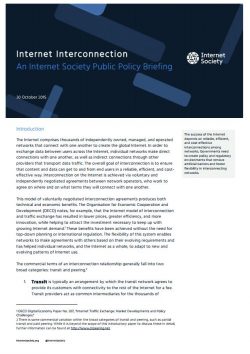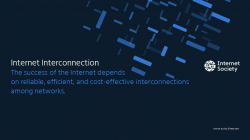Introduction
The Internet comprises thousands of independently owned, managed, and operated networks that connect with one another to create the global Internet. In order to exchange data between users across the Internet, individual networks make direct connections with one another, as well as indirect connections through other providers that transport data traffic. The overall goal of interconnection is to ensure that content and data can get to and from end users in a reliable, efficient, and cost-effective way. Interconnection on the Internet is achieved via voluntary and independently negotiated agreements between network operators, who work to agree on where and on what terms they will connect with one another.
This model of voluntarily negotiated interconnection agreements produces both technical and economic benefits. The Organisation for Economic Cooperation and Development (OECD) notes, for example, that the Internet model of interconnection and traffic exchange has resulted in lower prices, greater efficiency, and more innovation, while helping to attract the investment necessary to keep up with growing Internet demand. [1] These benefits have been achieved without the need for top-down planning or international regulation. The flexibility of this system enables networks to make agreements with others based on their evolving requirements and has helped individual networks, and the Internet as a whole, to adapt to new and evolving patterns of Internet use.
The commercial terms of an interconnection relationship generally fall into two broad categories: transit and peering. [2]
1 Transit is typically an arrangement by which the transit network agrees to provide its customers with connectivity to the rest of the Internet for a fee. Transit providers act as common intermediaries for the thousands of networks on the Internet that would otherwise have to be directly connected with each other. Some transit providers operate international networks with the ability to move data across the globe. This enables the customer purchasing transit to reach many end points without having to physically connect to and negotiate agreements with each one.
2 Peering is typically an agreement by which two networks agree to a mutual exchange of traffic to and from users on their own networks (but not via their transit links), usually on a “settlement-free” [3] or no-cost basis. Peering arrangements reduce the amount of traffic a network must send through its upstream transit provider, potentially lowering the average cost of traffic delivery. To facilitate peering, many networks choose to build connections to and participate in various local, regional, and global Internet exchange points (IXPs). IXPs are physical locations at which many different networks meet to peer and exchange traffic over a common switching infrastructure.
A variety of Internet actors and networks seek to interconnect with one another. Some include:
> Internet service providers (ISPs). ISPs own or resell facilities that bring Internet access to residential and business end users. ISP end users both consume and generate Internet traffic.
> Regional/global transit providers. These actors typically provide access to the global Internet for ISPs and others, allowing them to access distant networks. Their networks typically span longer distances than local ISPs.
> Content providers. Content providers are producers and distributors of Internet content. Some examples include media companies (distributing films, music, or videos), webhosting companies, social media networks, and software companies. In recent years, many content providers have built their own distribution networks or have chosen to buy services from Content Delivery Networks that specialized in distributing content to end users.
> Content delivery networks (CDNs). The role of a CDN is to efficiently and reliably distribute content on behalf of its primary customers, the content providers. CDNs aim to place their content as close to the end user as technically and commercially possible. CDNs often have servers in many datacenters around the globe, which makes it easier to interconnect with ISPs close to end users.
> Governments, private companies, and universities. These organizations often operate their own data networks and seek interconnection with other networks in order to achieve global reachability on the Internet.
Network operators typically have interconnection relationships with many different players and use a mix of peering and transit arrangements as part of their overall interconnection strategies.
Key Considerations
Before making interconnection agreements, most network operators evaluate the technical, business, and legal/regulatory aspects of establishing connections with prospective partners.
From a technical point of view, network operators seek interconnection points that create the most efficient traffic flows to and from their users, thereby providing robust data flows and positive end-user satisfaction. Key technical considerations include the capacity of the prospective partner’s network, the type of data carried by the network, the availability of suitable connection infrastructure, and the distance required to reach an agreed physical interconnection point, among others.
From a business perspective, network operators typically seek the most reliable traffic exchange at the lowest feasible cost and under terms and conditions flexible enough to meet their end users’ evolving needs. When making commercial arrangements, network operators consider factors such as the type of end user and content they can reach through the other network, traffic volumes, business and growth plans, and commercial terms. Network operators also consider the cost of connecting to a prospective interconnection partner and the transit or peering terms being offered. Around the world, IXPs create efficient interconnection ecosystems that attract datacenters and networks to the same location in search of both peering and transit, as well as other information and communication services.
Legal and regulatory factors also influence the desirability of a market as a place for interconnection. For example, legal or regulatory frameworks that specify who can interconnect, how data must be routed, commercial terms and conditions, or physical or technical requirements for interconnection, can create disincentives for interconnecting with and between networks in a jurisdiction. Government-mandated monopolies, onerous licensing requirements (including for in-country and cross-border operations), and unclear business environments can also negatively impact the development of a robust interconnection and traffic exchange ecosystem.
Challenges
The key challenge for policymakers is to cultivate an environment that fosters dynamic, efficient, and flexible network interconnection. Governments can provide leadership by ensuring their regulatory and legal systems create an enabling rather than a restrictive environment. Competitive markets offer the greatest opportunity for parties to find interconnection partners that will help achieve networking goals and advance business strategies. Creating a competitive market for access networks, metropolitan and national data transport, and international capacity, and encouraging the development of IXPs are key ways to improve a country’s local and regional interconnection environment.
While many developing and emerging markets have had success in growing local access networks and Internet penetration, many countries still lack datacenters and locally hosted content that ISPs can connect to locally. [4] Although national networks may be interconnected (for example, via a local IXP), if their users mostly interact with users and data outside of their local region, a large proportion of their Internet traffic will still transit expensive international links. To address this challenge, governments can promote local content development, thereby promoting datacenter development and local hosting, and attracting CDNs in-country.
Network operators need to understand the economic, business, technical, and operational aspects of Internet interconnection in order successfully develop and manage interconnection strategies. Operators in many developing and emerging markets, however, are relatively new to thinking about interconnection strategy as a means to improving the technical and business aspects of their services. Network operators should take advantage of capacity building opportunities to improve peering and interconnection knowledge and skills. [5]
Faced with the challenge of high connectivity costs, some governments have proposed that international regulations should be put in place to govern Internet interconnection. Many of these proposals have suggested imposing the kind of “sending-party-pays” or “cost sharing” arrangements that are common in the traditional telephony market to the Internet. [6] In our analysis [7] such proposals run the risk of fragmenting the Internet and producing significant negative impacts in developing countries. In contrast, data have shown [8] that the promotion of competitive markets, IXPs, and supportive policy environments have a significant positive impact on reducing costs, including for international connectivity.
Guiding Principles
Broad and efficient Internet interconnection is critical for the continued growth and stability of the local, regional, and global Internet. Governments have a role in creating environments that provide choices and flexibility for interconnecting networks, while also removing artificial barriers. Guiding principles include:
> Create an enabling environment by adopting policies that promote and facilitate network interconnection. The environment should encourage network operators to build, lease, or buy the necessary infrastructure to connect with others (including across borders), and to make voluntarily negotiated peering and transit agreements with commercially viable terms and conditions at interconnection points of their choice.
> Remove government-imposed monopolies on Internet infrastructure and traffic exchange, including monopolies on cable landing stations, international gateways, cross-border capacity, and local/regional backbones. Related policies should also promote both domestic and foreign investment in Internet infrastructure and services.
> Work with regional counterparts and regional organizations to implement regional policy frameworks that support cross-border Internet interconnection and advance the alignment of cross-border licensing regimes.
> Encourage the development of IXPs to facilitate peering, lower network operating costs, improve network performance, and build resiliency.
> Promote the development of local content and datacenter infrastructure, including carrier-neutral datacenters (that are not run by ISPs or transit providers).
> Encourage network operators to participate in capacity-building opportunities in order to increase their knowledge of the economic, business, technical, and operational aspects of Internet interconnection.
Additional Resources
The Internet Society has published a number of papers and additional content related to this issue. These are available for free access on the Internet Society website.
> Internet Interconnections: Proposals for New Interconnection Model Comes Up Short, http://www.internetsociety.org/internet-interconnections-proposals-new-interconnection-model-comes-short
> UNECA CODIST–II Workshop Report: Legal and Regulatory Aspects of Interconnection, http://www.internetsociety.org/uneca-codist-ii-workshop-report-legal-and-regulatory-aspects-interconnection
> Lifting barriers to Internet development in Africa: Suggestions for improving connectivity. English: http://www.internetsociety.org/doc/lifting-barriers-internet-development-africa-suggestions-improving-connectivity
> Promoting Local Content Hosting to Develop the Internet Ecosystem. English: http://www.internetsociety.org/doc/promoting-local-content-hosting-develop-internet-ecosystem
> Assessment of the impact of Internet Exchange Points (IXPs)—empirical study of Kenya and Nigeria. http://www.internetsociety.org/ixpimpact
Notes
[1] OECD Digital Economy Paper No. 207, “Internet Traffic Exchange: Market Developments and Policy Challenges.”
[2] There is some commercial variation within the broad categories of transit and peering, such as partial transit and paid peering. While it is beyond the scope of this introductory paper to discuss these in detail, further information can be found at http://www.drpeering.net.
[3] “Settlement-free peering” means that neither party pays the other for the exchange of peered traffic between the two networks.
[4] See the Internet Society report, Promoting Local Content Hosting to Develop the Internet Ecosystem, for a fuller discussion of locally hosted content dynamics.
[5] Among other capacity building resources, many Internet technical community organisations and groups (such as the Regional Internet Registries, local and regional Network Operator Groups, Internet Society, Network Start-up Resource Center, and Packet Clearing House, among others) offer free or low-cost training on various aspects of Internet interconnection, peering and traffic exchange.
[6] For example, ITU-T D.50 Supplement 2, Section 3.7, discusses “cost sharing” approaches for international connectivity.
[7] See the Internet Society paper, Internet Interconnection—Proposals for New Interconnection Model Comes Up Short.
[8] See the Internet Society reports, Lifting barriers to Internet development in Africa: suggestions for improving connectivity, and Assessment of the impact of Internet Exchange Points (IXPs)—empirical study of Kenya and Nigeria.

